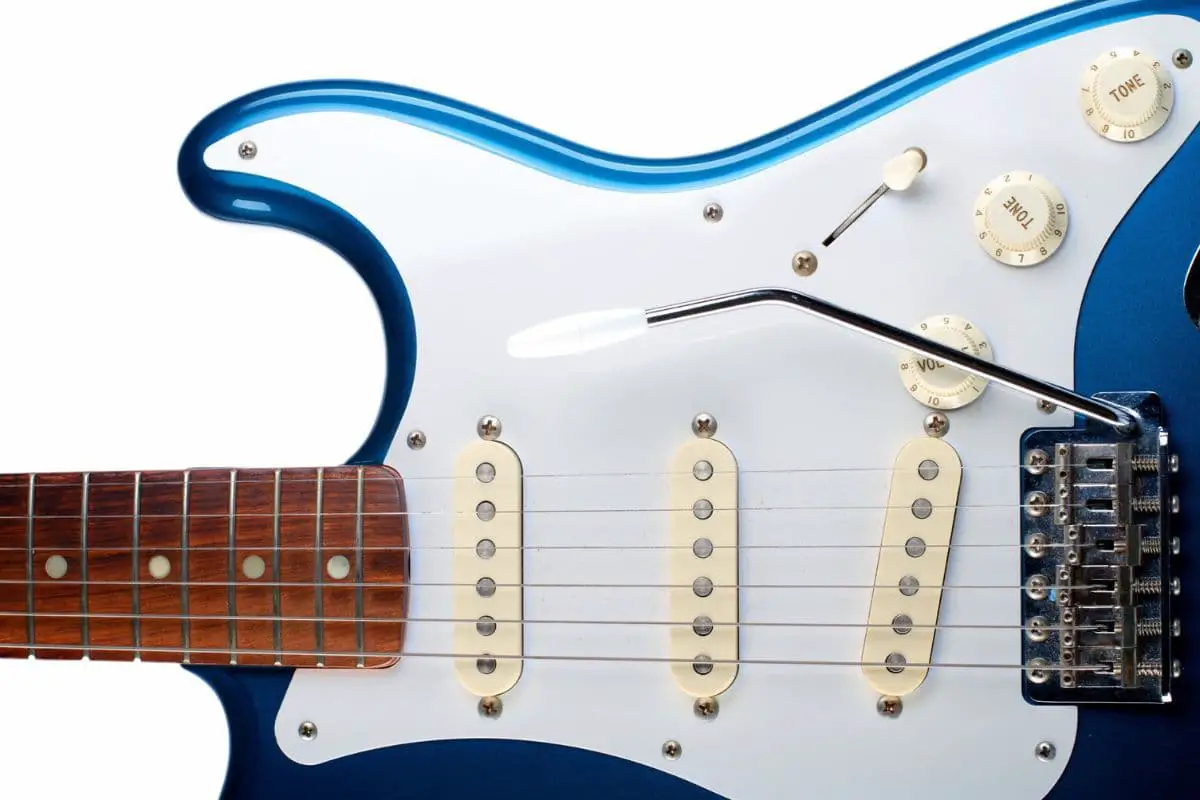The whammy bar brings a vast array of tonal possibilities to a guitar that can be both exciting and confusing for new guitar players. Before diving into the exploration of this amazing invention, one has to first deal with its installation.
To install a whammy bar on guitars with vibrato systems, insert the bar into the hole provided for it and screw it clockwise until you begin to feel some resistance. This applies to threaded whammy bars. For systems using non-threaded bars, simply push the bar into place, and you’re done.
In this article, I’ll be taking you through everything you need to know about installing a whammy bar on your electric guitar, no matter its type. So, make sure to keep reading until the end to learn more.
If you want to find out what my recommended guitar gear is, then here is what I recommend on Amazon:
- Fender Cutaway Acoustic-Electric Guitar Bundle (MY FAVORITE GUITAR)
- Snark SN-8 Super Tight All Instrument Tuner (Easiest Tuner I’ve Used)
- 6 String Acoustic Guitar Capo (Best CAPO for quick changes)
- Dunlop Max Grip 1.0mm Nylon Picks (Thick Guitar Pick So You Don’t Lose Grip!)
- Universal Guitar Stand (Cheap & Minimalist Guitar Stand I Recommend)
- Levy’s 2″ Wide Quick Adjust Guitar Strap (Best Guitar Strap For Any Level)
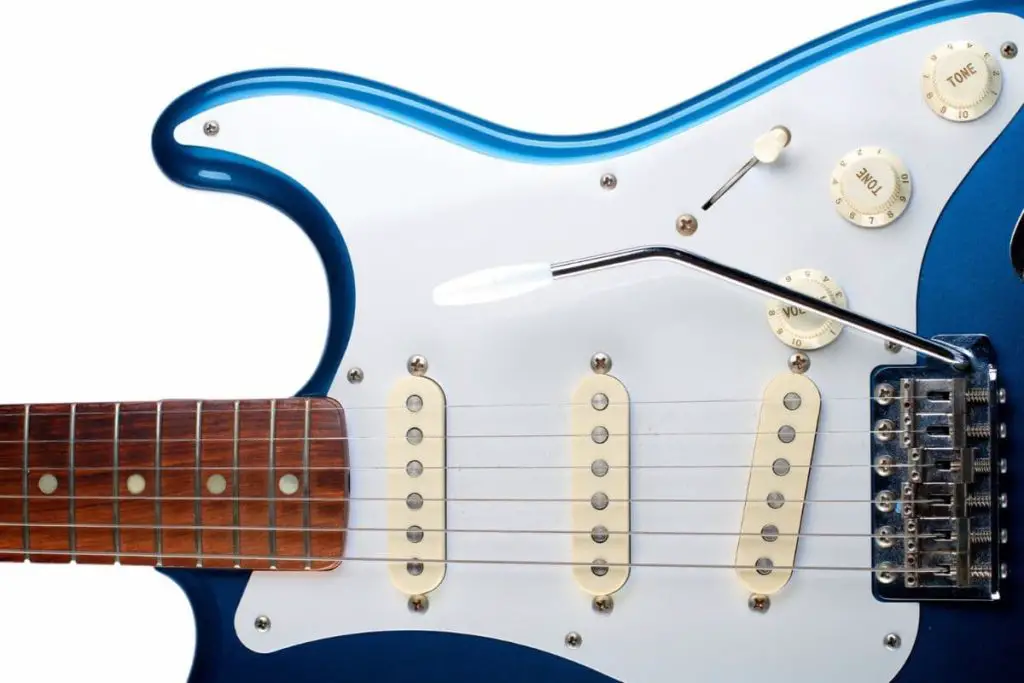
How To Install a Whammy Bar on Different Electric Guitars
The answer given above is by no means an exhaustive one. This is because the whammy, which was first synonymous with the Stratocaster guitar, has long ceased to be that restricted. Given this development, we shall take some time to look at how one can enjoy the whammy effect on different types of guitars.
In discussing this topic, it is essential to understand that you can only use the whammy bar on a guitar equipped to receive it. These are usually guitars with vibrato or tremolo bridges, as they are more popularly called.
Just a point to note; the tremolo bridge was named by Fender. Tremolo, in music, refers to a rapid modulation in the volume of a sound. However, since the actual action that occurs with the use of a whammy bar is the modulation of the pitch of a sound, calling it a tremolo system is technically wrong. The accurate description, which many people now use, is a vibrato system.
That said, since the system is still widely known as tremolo, I’ll use both terms interchangeably in this article to mean the same thing. It’s just important that you understand why you may see two different names for the same thing.
Without further ado, let’s get into the process of installing a whammy bar on different electric guitars.
Installing a Whammy Bar on a Stratocaster
This is probably the easiest guitar to install a whammy bar on. As mentioned above, whammy bars were traditionally a Stratocaster thing, and many Stratocasters still come preinstalled with the type of bridge required for using the whammy bar.
To install a whammy bar on a Stratocaster, simply insert the included whammy bar or a suitable one you got into the hole in the bridge designed for it. The bar will most likely be threaded, so turn it in a clockwise motion until you feel the beginning of some resistance.
You can watch this video for a visual guide:
How tight or loose it should be is often an issue of personal preference. Many guitar players, however, advise against screwing the bar too tight into the hole.
If you happen to own a guitar that requires an unthreaded bar, all you need to do is push the right bar. There will be no need to screw it into place.
Installing a Whammy Bar on Other Types of Guitars
There’s a wide range of types of electric guitars. Some of these include the Telecaster (also a Fender design), Gibson’s SG, Les Paul, and hollow and semi-hollow guitars. Traditionally, these guitars do not come equipped with the ability to utilize a whammy bar.
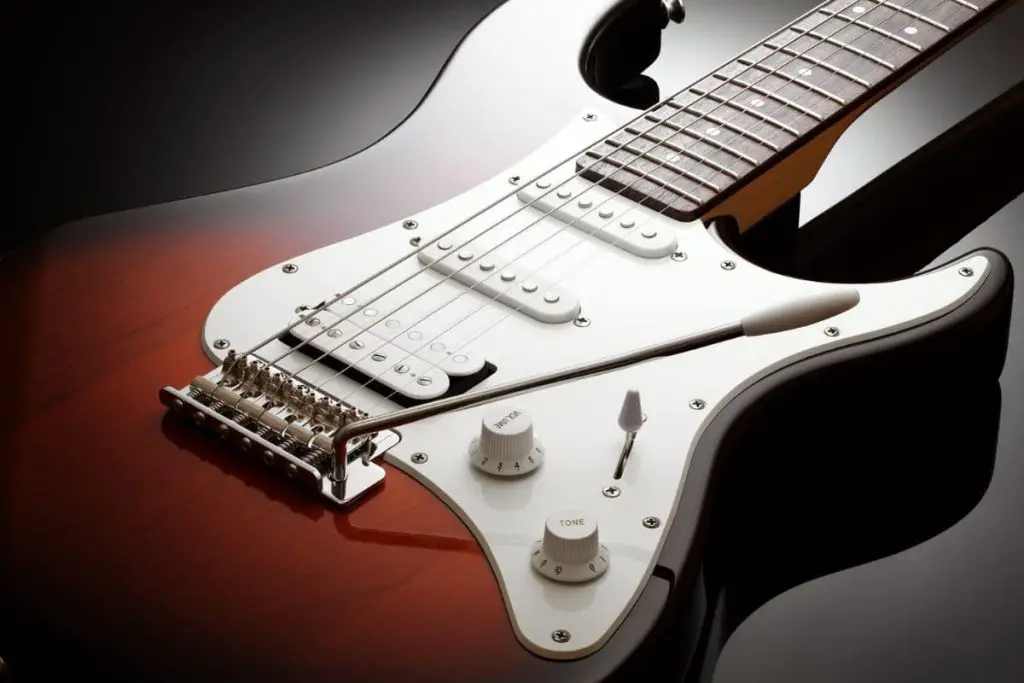
Today, many of these guitars have models equipped with a bridge suitable for whammy bar use. Even those not so equipped can now be modified to accept whammy bars.
For better clarity, we’ll look at how whammy bars can be used on Telecasters, Les Pauls, SGs, and other guitars. To help us understand the process better, we’ll start by looking at some of these guitars and the types of tremolo bridges that either come with them or are used to modify them.
Installing a Whammy Bar on a Telecaster
Though the vibrato system for guitars had been invented decades before the creation of the Telecaster, none of the designs available were considered stable and really viable until the Bigsby was invented in 1952. Since Fender’s Telecaster, which was then known as the Broadcaster, was invented in 1950, it did not come with an onboard vibrato (Tremolo) system.
Being a well-loved guitar, the Telecaster retained this original design. Fender, however, went on to satisfy the needs of guitarists who wanted the vibrato system by creating the Stratocaster, which came with a vibrato system from the get-go.
That said, some players still want to enjoy the sound and tone of the Telecaster, plus the ability to add some of the tremolo effect of the whammy bar. While it’s possible to have some manufacturers create a Telecaster-like guitar with a vibrato (tremolo) system installed, the most common solution that guitarists use is modifying the Telecaster to install a vibrato system.
One tremolo (vibrato) system that many regard as the best option for the Telecaster is the Super-Vee Maverick Telecaster Tremolo System. Super-Vee started with a design that was regarded by many as an improvement on the standard Stratocaster bridge. This new, improved bridge was known as the Super-Vee Bladerunner and was specifically designed for the Stratocaster.
The Maverick Telecaster, on the other hand, as you may have guessed from the name, is a design specially made for the Telecaster. It’s designed in such a way that it does not alter the outer appearance of your Telecaster. That said, it is not a project that should be entered into without some knowledge of woodworking and guitar construction.
You may also require some tools that aren’t usually found in most households. Most guitar players will be better off having professionals install it for them.
The reason for this is the somewhat complex routing process required. You can watch this video to better understand what I mean:
For a real-life example of the reaction to the work required for installing the Super-Vee Maverick Telecaster Tremolo System on a Telecaster, I’ll share with you what a senior member on a Guitar Forum had to say about it.
A user had asked this question: “Anyone try the Super-Vee Maverick trem for Tele?“
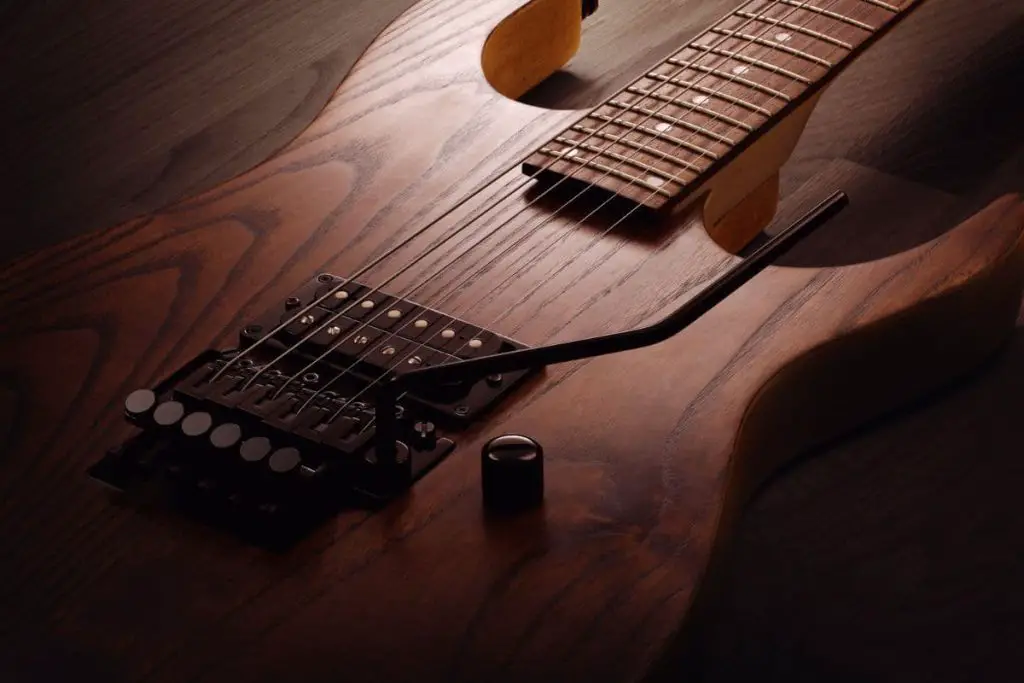
To this question, the senior member answered: “It scares me.” His reason was mainly the routing process which he described as scary. He also noted the uncertainties surrounding the modification’s possible future effects on the guitar.
That said, other guitar players have done it and had varying success levels to report.
Here’s a video showing the Super-Vee Maverick Telecaster Tremolo System in actual use:
If you decide to try it out, understand that you may be making irreversible changes to your axe.
Indeed, there are other tremolo (vibrato) systems that can be used with the Telecaster. Some of these include the Floyd Rose and the Bigsby. Since the Bigsby is relatively easy to install and does not require you to make any irreversible changes on your guitar, we will discuss how to install one on a Telecaster.
To install a Bigsby bridge on your Telecaster, you first need to understand that the exact process will depend on your Telecaster model. Knowing this, you will be able to choose the right accessories with which to install the Bigsby bridge. There’s also the issue of selecting the Bigsby model that will work best with your Telecaster.
For this guide, we’ll look at installing a Bigsby B5 “F” Logo on a vintage-style Telecaster. You’ll be using the following items:
- Bigsby B5 “F”Logo Bridge.
- Bigsby Mounting Bracket.
- Vibramate Ash Tray (Adaptor).
- Vibramate Spoilers.
- Vibramate Saddles.
- String Winder (Optional).
- Screwdrivers.
To install the Bigsby B5 Bridge on a vintage-style Telecaster, take the following steps:
- Remove the strings.
- Remove the saddles. Lay a soft cloth over your guitar body to avoid scratches from the screw.
- Unscrew the ashtray but do not remove it. Save the screws for your new installation.
- Unscrew the pickup still attached to the ashtray. You should also save the screws and washers for your new installation.
- With the pickup unscrewed, you can now remove the ashtray.
- Get the Vibramate ashtray and fit it over the pickup.
- Screw the pickup into the new ashtray using the screws and washer you saved from earlier.
- Position the ashtray (with the pickup now installed) and screw it back into place using the screws you saved from the old ashtray.
- Install the new saddles. Your old saddles will work, but they won’t offer the dual access option that the Vibratemate saddles offer.
- Unscrew the bottom strap nut and keep it aside because you will reuse it.
- Position the horseshoe guide for the Bigsby. The two ends of the U shape should fit into the base of the installed ashtray, while the bottom of the U should align with the hole for the strap nut.
- Replace the strap nut and screw it in to hold in the horseshoe guide.
- Unscrew the nuts and rubber washers from the top of the horseshoe guide so you can install the Bigsby.
- Remove the small protective pads placed under the Bigsby.
- Place the Bigsby on the horseshoe guide, ensuring that it sits securely.
- Insert the rubber washers over the protruding screws.
- While screwing the nuts over the washers, ensure that you use the different nut for the hole where the spring arm will rest.
- Tighten the nuts, and be sure not to tighten them too hard.
- With the nuts, all tightened, get the included spring and washer.
- Place the spring in the hole with the different nut (where the arm will rest).
- Insert the washer over the protruding end attached to the Bigsby arm. This end should go into the spring when the arm is lowered.
- String the guitar in the traditional way or using the Vibramate string spoiler.
- Once done, intonate and tune your guitar.
Following all the steps above, your guitar should be ready for jamming. Note that you may have issues fitting the modified guitar into your case. To ensure it fits in, rotate the arm to the back of the guitar, and it should fit.
Another important thing I’ll point out is that this is an excellent time to give your guitar a thorough cleaning. With the strings and bridge out of the way, you have access to every corner of the guitar and should therefore take the opportunity to give it a good cleaning.
Installing a Whammy Bar on a Les Paul
As with the Telecaster, Gibson’s Les Paul is not naturally equipped with a vibrato system. Many professional guitarists actually frown at the thought of modifying a Les Paul to include a vibrato system.
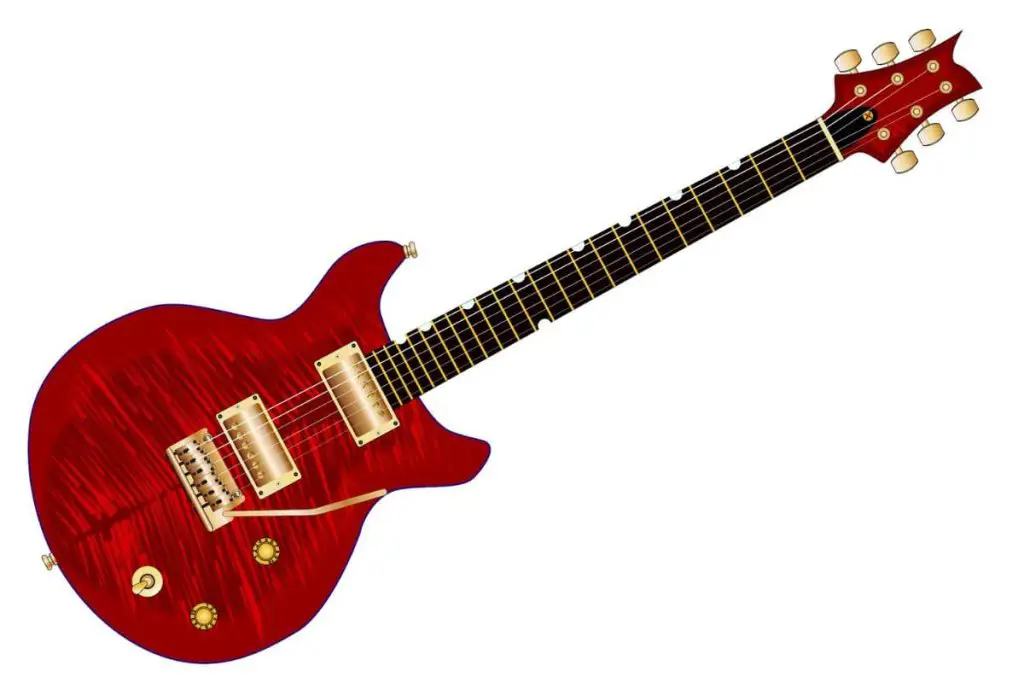
Despite the frowns of these purists, some guitarists still want to have the ability to enjoy the whammy bar on their Les Paul. Where there is demand, there eventually will be supply.
First, Gibson introduced some Les Paul models with options to have Floyd Rose bridges on them. The Floyd Rose bridge is one of the vibrato bridges available for installation on different guitars that do not come with vibrato bridges.
One popular vibrato system used for the Les Paul is the Bigsby bridge. Many prefer it over other options, like the Floyd Rose, because you do not have to bore holes into the guitar to install it. All you need is a Vibramate adaptor and the Bigsby bridge.
To install the Bigsby bridge on a Les Paul guitar, take the following steps:
- Remove the guitar strings.
- Unscrew and remove the stock bridge.
- Clean the guitar thoroughly before continuing.
- Attach the Vibramate adaptor, screwing it into the holes from which the stock bridge was removed.
- Remove the strap button from the guitar’s bottom.
- Attach the Bigsby bridge to the space prepared for it on the Vibramate.
- Screw the tapered end of the Bigsby to the screw hole from which you removed the strap button.
- Lift the tremolo arm attached to the Bigsby.
- Place the included washer over the screw-like extended part of the tremolo arm close to where it is attached to the main bridge.
- Place the included spring on the receptacle into which the screw-like extended part of the arm rests on.
- Replace the tremolo arm.
If you followed the steps correctly, you should be ready to enjoy some whammy tricks on your Les Paul. Note that there’s no need to install a whammy bar in this case as Bigsby’s tremolo arm is attached to the bridge.
You can watch this process in this video:
Installing a Whammy Bar on an SG
The SG, or Solid Guitar, is another guitar from Gibson, but a later model. It was designed in 1961, much later than the Les Paul. Unlike the Les Paul, some models of the SG came with tremolo bridges but were reported to be horrible.
Thanks to the technological advancements that have been made over the years, we now have new and more reliable tremolo (vibrato) bridges. A Bigsby bridge can be installed on the SG. The same process described for installing the Bigsby on a Les Paul still applies here. Just ensure you choose the Vibramate and Bigsby bridge models that suit your SG design.
You can watch this video for more clarity on choosing the correct Vibramate for your SG model:
Aside from the Bigsby, another type of bridge that can be installed on the SG is the Floyd Rose bridge.
Other Alternatives
Aside from the Bigsby and Floyd Rose tremolo bridges, there are some other options that guitar players can explore. There’s hardly any guitar that cannot now be equipped with a tremolo (vibrator) system.
Here are a few other options that you may want to consider:
- Stetsbar – This is an after-market tremolo system designed for use on a variety of guitars without modifying the instrument.
- Duesenberg Les Trem II – Manufactured by Duesenberg Guitars and designed for guitars featuring a tune-o-Matic bridge with its stop-tailpiece.
- Kahler – The Kahler tremolo bridge achieves the vibrato effect with a cam system, not the more common fulcrum. It will, however, not work with guitars that have rounded tops.
- Strandberg – EGS Tremolo – Designed by renowned guitar builder Ola Strandberg, it uses needle bearings instead of the more common fulcrum or cam to deliver a smooth operating tremolo system. This bridge is also made with aircraft-grade aluminum to ensure impressive durability.
- Trem King – This bridge is designed to act both as a hardtail and also a tremolo bridge. This means that it can operate as a regular bridge when used without the whammy bar and as a tremolo bar when the bar is inserted.
- Virtual Jeff Pro – This is an interesting piece of innovation. Regarded as a digital whammy, it provides the fun effects of the whammy bar without the negatives associated with it.
Can You Install a Whammy Bar on Any Electric Guitar?
You can install a tremolo system on any electric guitar. Different types of tremolo systems are now available for different types of guitars. Examples include Stetsbar, Virtual Jeff Pro, Bigsby, and Floyd Rose.
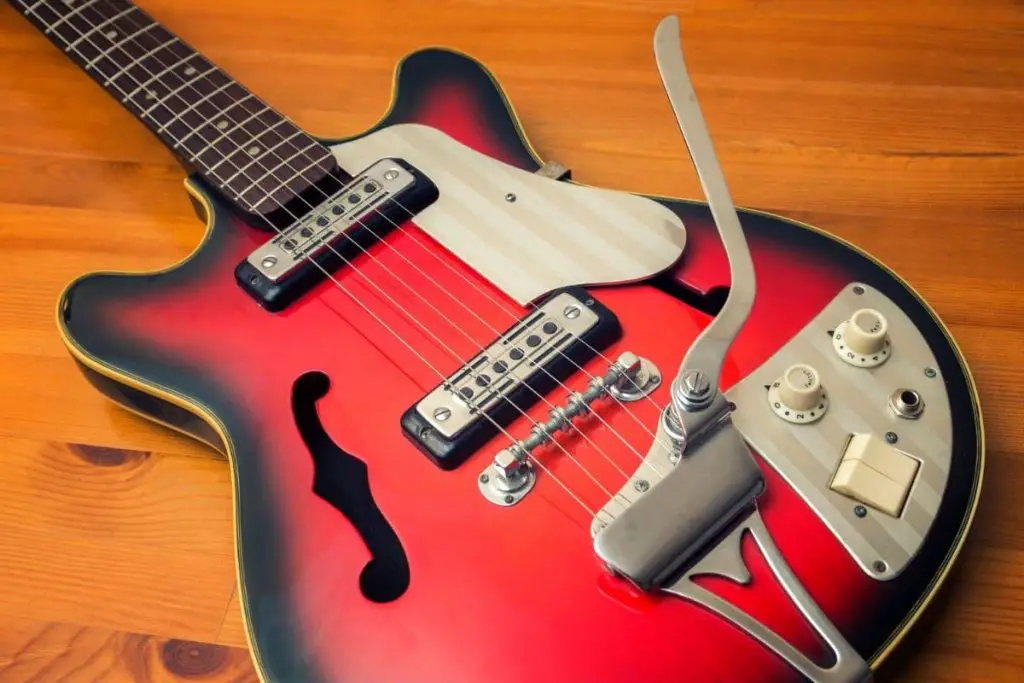
Final Thoughts On The Whammy Bar for Guitar
In the beginning of this article, we started out by looking at how to install a whammy bar on guitars like the Stratocaster.
Later on, we moved on to looking at how other guitars can enjoy the benefits of the whammy system. Having read this article, you should now have a better understanding of the whammy bar, how it works, and what is required to have one such system installed on your guitar.
Here are some common questions about the whammy bar.
Does the whammy bar just screw in?
The whammy bar, also known as the tremolo arm, is a movable arm that is attached to the bridge of an electric guitar with a threaded screw. The design of the whammy bar and its attachment to the guitar can vary depending on the specific make and model of the guitar.
In most cases, the whammy bar is attached to the guitar by screwing it into a threaded insert on the bridge plate. Some guitars may have a separate piece called a “whammy bar bushing” that is screwed into the bridge plate, which the whammy bar then screws into.
When attaching the whammy bar to the guitar, it’s important to be careful not to overtighten it, as this can cause damage to the threaded insert or bushing. It’s also important to make sure the whammy bar is screwed in securely, but not so tight that it cannot be moved easily.
If you’re not sure how to attach the whammy bar to your guitar, it’s best to consult the owner’s manual or take it to a professional technician or guitar shop for assistance. They can help you properly install the whammy bar and make any necessary adjustments to ensure it functions properly.
How tight to screw in whammy bar?
As a general rule of thumb, you should tighten the whammy bar until it feels snug and secure, but not so tight that it becomes difficult to move or adjust. The exact tightness will vary depending on the specific make and model of the guitar, as well as the preferences of the player.
If you’re not sure how tight to screw in the whammy bar on your guitar, it’s best to consult the owner’s manual or take it to a professional technician or guitar shop for assistance. They can help you properly install the whammy bar and make any necessary adjustments to ensure it functions properly.
Do whammy bars damage guitars?
When used properly, whammy bars generally do not cause any damage to guitars. However, if the whammy bar is used improperly or if it is poorly designed or installed, it can potentially cause damage to the guitar.
For example, if the whammy bar is screwed in too tightly, it can strip the threads on the bridge plate or cause other damage. Similarly, if the whammy bar is pulled or pushed too hard, it can cause the strings to go out of tune or even break.
Additionally, using a whammy bar can put additional stress on the guitar’s neck and body, especially if the player is using the bar aggressively or frequently. Over time, this additional stress can cause the guitar to become misaligned or even crack.
To minimize the risk of damage, it’s important to use the whammy bar carefully and to follow the manufacturer’s instructions for installation and use. It’s also important to have the guitar inspected and adjusted regularly by a professional technician or guitar shop to ensure that it is properly set up and in good condition.
Does Jimi Hendrix use whammy bar?
Jimi Hendrix was well-known for his use of the whammy bar, which he used extensively in his music to create unique and innovative sounds on the guitar. Hendrix’s use of the whammy bar was a key element of his distinctive style and helped him to achieve many of the iconic guitar sounds that he is known for.
Hendrix used a variety of different whammy bar techniques in his playing, including dive bombs, vibrato, and subtle pitch shifts. He often used the whammy bar to create wild and dramatic sound effects, and he was known for pushing the limits of what the guitar could do in terms of sound and technique.
Overall, Hendrix’s use of the whammy bar was a major influence on the development of rock and roll guitar playing, and his innovative techniques helped to push the boundaries of what was possible on the instrument.
What guitars can use a whammy bar?
Most electric guitars that have a bridge with a vibrato unit, also known as a tremolo system, can use a whammy bar. Some examples of guitar models that commonly feature a whammy bar or tremolo system include the Fender Stratocaster, Fender Telecaster, Gibson SG, and various models from companies like Ibanez, Jackson, and Schecter.
However, not all electric guitars are designed to use a whammy bar. Some guitars, such as Gibson Les Pauls, do not have a vibrato unit and are not intended for whammy bar use. Other guitars may have a fixed bridge, which means the strings are anchored to the body of the guitar and cannot be adjusted for pitch using a whammy bar.
Who is the king of whammy bar?
The title of “king of the whammy bar” is somewhat subjective and there have been many guitarists who have pushed the limits of what the whammy bar can do in their playing. However, there are a few players who are often cited as being particularly influential in terms of their use of the whammy bar.
One of the most famous whammy bar players is Jimi Hendrix, who is widely regarded as a pioneer of the technique. Hendrix’s use of the whammy bar was a key element of his innovative and groundbreaking guitar playing, and he is known for pushing the boundaries of what was possible on the instrument.
Another guitarist who is often cited as a master of the whammy bar is Eddie Van Halen, who used the technique extensively in his playing. Van Halen was known for his innovative approach to the guitar and his use of the whammy bar helped to create some of the most iconic sounds in rock music.
Other guitarists who are known for their use of the whammy bar include Steve Vai, Joe Satriani, Jeff Beck, and Dimebag Darrell, among others. Each of these players has made significant contributions to the development and evolution of the whammy bar technique and has helped to shape the sound and style of modern guitar playing.
Who popularized the whammy bar?
The whammy bar, also known as the vibrato arm or tremolo arm, was first popularized in the 1950s by guitarist and inventor Paul Bigsby. Bigsby designed the first vibrato system for guitar in the 1940s, which was later adapted into the whammy bar that we know today.
However, it was not until the 1960s that the whammy bar became widely popular among guitarists, largely due to the influence of Jimi Hendrix. Hendrix’s innovative use of the whammy bar helped to push the limits of what was possible on the instrument and helped to popularize the technique among a new generation of guitarists.
In the years that followed, other influential guitarists like Eddie Van Halen, Steve Vai, and Joe Satriani helped to further develop and refine the whammy bar technique, leading to its widespread use in many different genres of music. Today, the whammy bar is considered an essential part of the electric guitar’s vocabulary and is used by guitarists around the world to create a wide range of sounds and effects.
Why is it called a whammy?
One theory is that the term “whammy” comes from the idea of a sudden impact or blow, as in the phrase “whammy bar.” The sudden pitch shifts and dramatic sound effects that can be achieved with the whammy bar may have given rise to this name.
Another theory is that the term “whammy” comes from the phrase “put the whammy on,” which was a slang term in the 1940s and 1950s that meant to hex or cast a spell on someone. It’s possible that this phrase was applied to the guitar’s vibrato arm as a way of describing the transformative power of the technique.
Regardless of the origin of the term, the whammy bar has become an essential part of the electric guitar’s vocabulary, and the word “whammy” is now commonly used to refer to any type of dramatic and sudden shift in pitch or tone.
How important is a whammy bar for guitar?
The importance of a whammy bar, also known as a tremolo arm or vibrato bar, to a guitarist depends on their playing style and the type of music they are interested in. For some guitarists, the whammy bar is an essential tool for creating certain sounds and effects, while for others it is not a necessary part of their playing.
The whammy bar allows guitarists to create a range of pitch-bending and vibrato effects that can add expressive nuance to their playing. Some players use the whammy bar to create dive bomb effects, in which they rapidly lower the pitch of a note, while others use it to create subtle pitch shifts or vibrato effects. In certain styles of music, such as rock, metal, and surf music, the whammy bar is often used to create dramatic and expressive sound effects.
However, not all guitarists find the whammy bar to be a necessary part of their playing. Some players prefer a more straightforward, traditional sound and may find the whammy bar to be distracting or unnecessary. Additionally, the whammy bar can require some adjustment to the guitar’s tuning and setup, which may be more trouble than it’s worth for some players.
Ultimately, the importance of the whammy bar to a guitarist depends on their personal playing style and preferences. For those who enjoy experimenting with different sounds and effects, the whammy bar can be a valuable and essential tool, while for others it may be less important or even unnecessary.
What size whammy bar do I need?
The size of the whammy bar that you need for your guitar will depend on the type of guitar that you have and the specific tremolo system that is installed on it. Whammy bars come in different lengths and diameters, and they are designed to fit specific types of tremolo systems.
If you’re not sure what size whammy bar you need for your guitar, it’s a good idea to consult the manufacturer’s specifications or contact a guitar technician for advice. They can help you determine the correct size and style of whammy bar for your guitar, as well as provide guidance on how to install and adjust it properly.
It’s worth noting that different types of whammy bars may have slightly different feels and playability, so it’s a good idea to try out a few different options to find the one that feels best for your playing style. Some guitarists prefer a longer or thicker whammy bar for more control, while others prefer a shorter or thinner one for easier playing. Ultimately, the best whammy bar for you will depend on your personal preferences and playing style.
Are whammy bars worth it?
The whammy bar allows guitarists to create a range of pitch-bending and vibrato effects that can add expressive nuance to their playing. Some players use the whammy bar to create dive bomb effects, in which they rapidly lower the pitch of a note, while others use it to create subtle pitch shifts or vibrato effects. In certain styles of music, such as rock, metal, and surf music, the whammy bar is often used to create dramatic and expressive sound effects.
However, the whammy bar can also require some adjustment to the guitar’s tuning and setup, and it can be difficult to use effectively without practice and experience. Additionally, not all guitarists find the whammy bar to be a necessary part of their playing. Some players prefer a more straightforward, traditional sound and may find the whammy bar to be distracting or unnecessary.
How to Use A Guitar Whammy Bar
Here are some basic steps to help you use a guitar whammy bar:
- Attach the whammy bar to your guitar: If your guitar has a whammy bar, it should be attached to the bridge or tremolo system. Screw the whammy bar into place and make sure it’s secure.
- Practice basic techniques: To start using the whammy bar, practice basic techniques like bending the pitch of a single note up and down or adding vibrato to a sustained note. These techniques involve using the whammy bar to move the bridge or tremolo system and change the tension on the strings.
- Experiment with dive bombs and squeals: More advanced techniques with the whammy bar can create dramatic effects like dive bombs and squeals. To do a dive bomb, play a note and then push the whammy bar down toward the guitar body to rapidly lower the pitch of the note. To do a squeal, play a note and then pull the whammy bar up sharply to create a high-pitched squealing sound.
- Practice with a metronome: To master using the whammy bar, practice with a metronome to develop good timing and control. Start slow and gradually increase the tempo as you get more comfortable with the technique.
- Experiment with different effects: Once you have the basics down, experiment with different types of effects and playing styles. The whammy bar can be used to create a wide range of sounds, from subtle vibrato to wild, screaming solos.
If you want to find out what my recommended guitar gear is, then here is what I recommend on Amazon:
- Fender Cutaway Acoustic-Electric Guitar Bundle (MY FAVORITE GUITAR)
- Snark SN-8 Super Tight All Instrument Tuner (Easiest Tuner I’ve Used)
- 6 String Acoustic Guitar Capo (Best CAPO for quick changes)
- Dunlop Max Grip 1.0mm Nylon Picks (Thick Guitar Pick So You Don’t Lose Grip!)
- Universal Guitar Stand (Cheap & Minimalist Guitar Stand I Recommend)
- Levy’s 2″ Wide Quick Adjust Guitar Strap (Best Guitar Strap For Any Level)
Related Posts:

